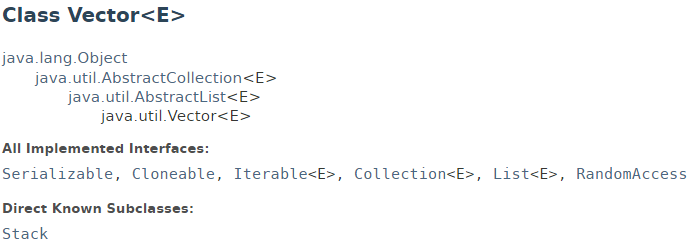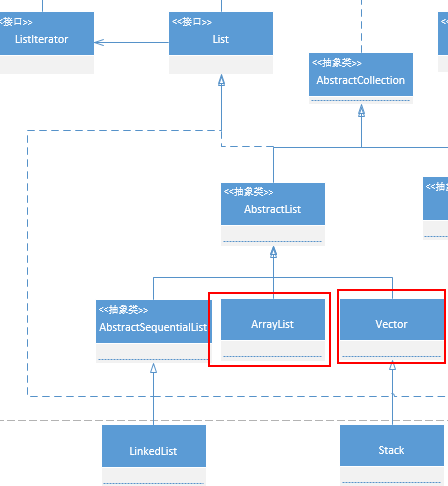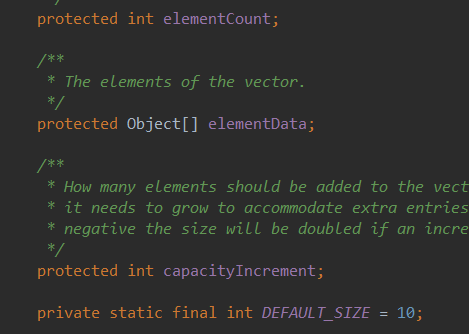点击查看 Java 集合框架深入理解 系列, - ( ゜- ゜)つロ 乾杯~
今天刮台风,躲屋里看看 Vector !
都说 Vector 是线程安全的 ArrayList,今天来根据源码看看是不是这么相似。
什么是 Vector
Vector 和 ArrayList 一样,都是继承自 AbstractList。它是 Stack 的父类。英文的意思是 “矢量”。
Vector 成员变量
1.底层也是个数组
protected Object[] elementData;
2.数组元素个数,为啥不就叫 size 呢?奇怪
protected int elementCount;
3.扩容时增长数量,允许用户自己设置。如果这个值是 0 或者 负数,扩容时会扩大 2 倍,而不是 1.5
protected int capacityIncrement;
4.默认容量
private static final int DEFAULT_SIZE = 10;
Vector 的 4 种构造方法
//创建默认容量 10 的数组,同时增长量为 0
public Vector() {
this(DEFAULT_SIZE, 0);
}
//创建一个用户指定容量的数组,同时增长量为 0
public Vector(int capacity) {
this(capacity, 0);
}
//创建指定容量大小的数组,设置增长量。如果增长量为 非正数,扩容时会扩大两倍
public Vector(int capacity, int capacityIncrement) {
if (capacity < 0) {
throw new IllegalArgumentException("capacity < 0: " + capacity);
}
elementData = newElementArray(capacity);
elementCount = 0;
this.capacityIncrement = capacityIncrement;
}
//创建一个包含指定集合的数组
public Vector(Collection<? extends E> c) {
//转成数组,赋值
elementData = c.toArray();
elementCount = elementData.length;
// c.toArray might (incorrectly) not return Object[] (see 6260652)
//可能有这个神奇的 bug,用 Arrays.copyOf 重新创建、复制
if (elementData.getClass() != Object[].class)
elementData = Arrays.copyOf(elementData, elementCount, Object[].class);
}
一个内部方法,返回一个新数组:
private E[] newElementArray(int size) {
return (E[]) new Object[size];
}
Vector 的成员方法
1.先来看 JDK 7 中 Vector 的 3 种扩容方式:
//根据指定的容量进行扩容
private void grow(int newCapacity) {
//创建个指定容量的新数组,这里假设指定的容量比当前数组元素个数多
E[] newData = newElementArray(newCapacity);
//把当前数组复制到新创建的数组
System.arraycopy(elementData, 0, newData, 0, elementCount);
//当前数组指向新数组
elementData = newData;
}
//默认增长一倍的扩容
private void growByOne() {
int adding = 0;
//扩容量 capacityIncrement 不大于 0,就增长一倍
if (capacityIncrement <= 0) {
if ((adding = elementData.length) == 0) {
adding = 1;
}
} else {
//否则按扩容量走
adding = capacityIncrement;
}
//创建个新数组,大小为当前容量加上 adding
E[] newData = newElementArray(elementData.length + adding);
//复制,赋值
System.arraycopy(elementData, 0, newData, 0, elementCount);
elementData = newData;
}
//指定默认扩容数量的扩容
private void growBy(int required) {
int adding = 0;
//扩容量 capacityIncrement 不大于 0
if (capacityIncrement <= 0) {
//如果当前数组内没有元素,就按指定的数量扩容
if ((adding = elementData.length) == 0) {
adding = required;
}
//增加扩容数量到 指定的以上
while (adding < required) {
adding += adding;
}
} else {
//扩容量大于 0 ,还是按指定的扩容数量走啊
adding = (required / capacityIncrement) * capacityIncrement;
//不过也可能出现偏差,因为是 int 做除法,所以扩容值至少是 指定扩容量的一倍以上
if (adding < required) {
adding += capacityIncrement;
}
}
//创建,复制,赋值一条龙
E[] newData = newElementArray(elementData.length + adding);
System.arraycopy(elementData, 0, newData, 0, elementCount);
elementData = newData;
}
2.(我能说一开始看错了,看成 JDK7 的了吗 - -)再来看JDK 8 中的扩容机制,变成一种了:
//扩容,传入最小容量,跟 ArrayList.grow(int) 很相似,只是扩大量不同
private void grow(int minCapacity) {
int oldCapacity = elementData.length;
//如果增长量 capacityIncrement 不大于 0 ,就扩容 2 倍
int newCapacity = oldCapacity + ((capacityIncrement > 0) ?
capacityIncrement : oldCapacity);
if (newCapacity - minCapacity < 0)
newCapacity = minCapacity;
if (newCapacity - MAX_ARRAY_SIZE > 0)
newCapacity = hugeCapacity(minCapacity);
//
elementData = Arrays.copyOf(elementData, newCapacity);
}
private static int hugeCapacity(int minCapacity) {
if (minCapacity < 0) // overflow
throw new OutOfMemoryError();
return (minCapacity > MAX_ARRAY_SIZE) ?
Integer.MAX_VALUE :
MAX_ARRAY_SIZE;
}
3.Vector中的 5 种添加元素的方法
//扩容前兆,检查数量
private void ensureCapacityHelper(int minCapacity) {
if (minCapacity - elementData.length > 0)
grow(minCapacity);
}
//在指定位置插入一个元素,同步的
public synchronized void insertElementAt(E obj, int index) {
modCount++;
if (index > elementCount) {
throw new ArrayIndexOutOfBoundsException(index
+ " > " + elementCount);
}
ensureCapacityHelper(elementCount + 1);
//扩容后就把插入点后面的元素统一后移一位
System.arraycopy(elementData, index, elementData, index + 1, elementCount - index);
//赋值
elementData[index] = obj;
elementCount++;
}
//尾部插入元素,同步的
public synchronized void addElement(E obj) {
modCount++;
ensureCapacityHelper(elementCount + 1);
elementData[elementCount++] = obj;
}
public void add(int index, E element) {
insertElementAt(element, index);
}
//添加一个集合到尾部,同步的
public synchronized boolean addAll(Collection<? extends E> c) {
modCount++;
//转成数组
Object[] a = c.toArray();
int numNew = a.length;
//扩容,复制到数组后面
ensureCapacityHelper(elementCount + numNew);
System.arraycopy(a, 0, elementData, elementCount, numNew);
elementCount += numNew;
return numNew != 0;
}
//添加一个结合到指定位置,同步的
public synchronized boolean addAll(int index, Collection<? extends E> c) {
modCount++;
if (index < 0 || index > elementCount)
throw new ArrayIndexOutOfBoundsException(index);
Object[] a = c.toArray();
int numNew = a.length;
ensureCapacityHelper(elementCount + numNew);
//要移动多少个元素
int numMoved = elementCount - index;
if (numMoved > 0)
//把插入位置后面的元素后移这么多位
System.arraycopy(elementData, index, elementData, index + numNew,
numMoved);
//复制元素到数组中
System.arraycopy(a, 0, elementData, index, numNew);
elementCount += numNew;
return numNew != 0;
}
最后还有个 ListIterator 的添加方法
public void add(E e) {
int i = cursor;
synchronized (Vector.this) {
checkForComodification();
Vector.this.add(i, e);
expectedModCount = modCount;
}
cursor = i + 1;
lastRet = -1;
}
4.Vector 中的 9 种删除方法
//删除指定位置的元素,同步的
public synchronized void removeElementAt(int index) {
modCount++;
if (index >= elementCount) {
throw new ArrayIndexOutOfBoundsException(index + " >= " +
elementCount);
}
else if (index < 0) {
throw new ArrayIndexOutOfBoundsException(index);
}
int j = elementCount - index - 1;
if (j > 0) {
//把删除位置后面的元素往前移一位
System.arraycopy(elementData, index + 1, elementData, index, j);
}
elementCount--;
//最后多余的一位置为 null
elementData[elementCount] = null; /* to let gc do its work */
}
//删除指定元素,同步的
public synchronized boolean removeElement(Object obj) {
modCount++;
int i = indexOf(obj);
if (i >= 0) {
removeElementAt(i);
return true;
}
return false;
}
E elementData(int index) {
return (E) elementData[index];
}
//删除指定位置的元素
public synchronized E remove(int index) {
modCount++;
if (index >= elementCount)
throw new ArrayIndexOutOfBoundsException(index);
E oldValue = elementData(index);
//找到删除该元素后,后面有多少位元素需要前移一位
int numMoved = elementCount - index - 1;
if (numMoved > 0)
//迁移一位
System.arraycopy(elementData, index+1, elementData, index,
numMoved);
//最后一位置为 null,不浪费空间
elementData[--elementCount] = null; // Let gc do its work
return oldValue;
}
public boolean remove(Object o) {
return removeElement(o);
}
//删除指定集合的所有元素,同步的
public synchronized boolean removeAll(Collection<?> c) {
//直接调用 AbstractCollection 的 removeAll 方法,用迭代器挨个删除
return super.removeAll(c);
}
//删除所有元素,同步的
public synchronized void removeAllElements() {
modCount++;
// 挨个置为空,Let gc do its work
for (int i = 0; i < elementCount; i++)
elementData[i] = null;
elementCount = 0;
}
//删除指定范围的元素,同步的
protected synchronized void removeRange(int fromIndex, int toIndex) {
modCount++;
//把结束位置以后的元素向前移动 指定数量个位置,覆盖
int numMoved = elementCount - toIndex;
System.arraycopy(elementData, toIndex, elementData, fromIndex,
numMoved);
// 把多余的位置置为 null
int newElementCount = elementCount - (toIndex-fromIndex);
while (elementCount != newElementCount)
elementData[--elementCount] = null;
}
//排除异己,同步的
public synchronized boolean retainAll(Collection<?> c) {
return super.retainAll(c);
}
//JDK 1.8 新增的
public synchronized boolean removeIf(Predicate<? super E> filter) {
Objects.requireNonNull(filter);
// 将要删除的内容加入 removeSet
int removeCount = 0;
final int size = elementCount;
final BitSet removeSet = new BitSet(size);
final int expectedModCount = modCount;
for (int i=0; modCount == expectedModCount && i < size; i++) {
@SuppressWarnings("unchecked")
final E element = (E) elementData[i];
if (filter.test(element)) {
removeSet.set(i);
removeCount++;
}
}
if (modCount != expectedModCount) {
throw new ConcurrentModificationException();
}
// 遍历,删除
final boolean anyToRemove = removeCount > 0;
if (anyToRemove) {
final int newSize = size - removeCount;
for (int i=0, j=0; (i < size) && (j < newSize); i++, j++) {
i = removeSet.nextClearBit(i);
elementData[j] = elementData[i];
}
for (int k=newSize; k < size; k++) {
elementData[k] = null; // Let gc do its work
}
elementCount = newSize;
if (modCount != expectedModCount) {
throw new ConcurrentModificationException();
}
modCount++;
}
return anyToRemove;
}
写“同步的”写的手抽筋,还是统计不是同步的方法吧 - -。
5. Vector 中的修改方法
//修改指定位置为指定元素
public synchronized E set(int index, E element) {
if (index >= elementCount)
throw new ArrayIndexOutOfBoundsException(index);
//找到这个元素,直接设置新值
E oldValue = elementData(index);
elementData[index] = element;
return oldValue;
}
//修改指定位置为指定元素
public synchronized void setElementAt(E obj, int index) {
if (index >= elementCount) {
throw new ArrayIndexOutOfBoundsException(index + " >= " +
elementCount);
}
//数组就是方便,直接更新就好了
elementData[index] = obj;
}
//修改数组容量
public synchronized void setSize(int newSize) {
modCount++;
//元素个数超出容量就要扩容
if (newSize > elementCount) {
ensureCapacityHelper(newSize);
} else {
//新增 elementCount - newSize 个元素
for (int i = newSize ; i < elementCount ; i++) {
elementData[i] = null;
}
}
elementCount = newSize;
}
//排序,修改顺序
public synchronized void sort(Comparator<? super E> c) {
final int expectedModCount = modCount;
//用的是 Arrays.sort
Arrays.sort((E[]) elementData, 0, elementCount, c);
if (modCount != expectedModCount) {
throw new ConcurrentModificationException();
}
modCount++;
}
//缩小数组容量,减少占用资源
public synchronized void trimToSize() {
modCount++;
int oldCapacity = elementData.length;
if (elementCount < oldCapacity) {
//新建个小点的数组,赋值
elementData = Arrays.copyOf(elementData, elementCount);
}
}
6. Vector 中的查询
//查找 o 从指定位置 index 开始第一次出现的位置
public synchronized int indexOf(Object o, int index) {
if (o == null) {
for (int i = index ; i < elementCount ; i++)
if (elementData[i]==null)
return i;
} else {
for (int i = index ; i < elementCount ; i++)
if (o.equals(elementData[i]))
return i;
}
return -1;
}
//查找 o 在数组中首次出现的位置
public int indexOf(Object o) {
return indexOf(o, 0);
}
//是否包含 O
public boolean contains(Object o) {
return indexOf(o, 0) >= 0;
}
//是否包含整个集合
public synchronized boolean containsAll(Collection<?> c) {
//调用 AbstractCollection 的方法,使用迭代器挨个遍历查找,两重循环
return super.containsAll(c);
}
//第一个元素,其实提供了 get() 方法就够了
public synchronized E firstElement() {
if (elementCount == 0) {
throw new NoSuchElementException();
}
return elementData(0);
}
//最后一个元素,其实提供了 get() 方法就够了
public synchronized E lastElement() {
if (elementCount == 0) {
throw new NoSuchElementException();
}
return elementData(elementCount - 1);
}
public synchronized boolean isEmpty() {
return elementCount == 0;
}
//实际包含元素个数
public synchronized int size() {
return elementCount;
}
//数组大小,>= 元素个数
public synchronized int capacity() {
return elementData.length;
}
7. Vector 也可以转成数组
public synchronized Object[] toArray() {
return Arrays.copyOf(elementData, elementCount);
}
//跟 ArrayList 简直一样
public synchronized <T> T[] toArray(T[] a) {
if (a.length < elementCount)
return (T[]) Arrays.copyOf(elementData, elementCount, a.getClass());
System.arraycopy(elementData, 0, a, 0, elementCount);
if (a.length > elementCount)
a[elementCount] = null;
return a;
}
8. Vector 中的迭代器
普通迭代器 Iterator:
public synchronized Iterator<E> iterator() {
return new Itr();
}
private class Itr implements Iterator<E> {
int cursor; // index of next element to return
int lastRet = -1; // index of last element returned; -1 if no such
int expectedModCount = modCount;
public boolean hasNext() {
// 调用 next() 前的检查
return cursor != elementCount;
}
public E next() {
//注意了,Vector 连迭代器的方法也加了同步
synchronized (Vector.this) {
checkForComodification();
int i = cursor;
if (i >= elementCount)
throw new NoSuchElementException();
cursor = i + 1;
return elementData(lastRet = i);
}
}
public void remove() {
if (lastRet == -1)
throw new IllegalStateException();
//注意了,Vector 连迭代器的方法也加了同步
synchronized (Vector.this) {
checkForComodification();
Vector.this.remove(lastRet);
expectedModCount = modCount;
}
cursor = lastRet;
lastRet = -1;
}
//大概看下这个 1.8 的方法
@Override
public void forEachRemaining(Consumer<? super E> action) {
Objects.requireNonNull(action);
synchronized (Vector.this) {
final int size = elementCount;
int i = cursor;
if (i >= size) {
return;
}
@SuppressWarnings("unchecked")
final E[] elementData = (E[]) Vector.this.elementData;
if (i >= elementData.length) {
throw new ConcurrentModificationException();
}
while (i != size && modCount == expectedModCount) {
action.accept(elementData[i++]);
}
// update once at end of iteration to reduce heap write traffic
cursor = i;
lastRet = i - 1;
checkForComodification();
}
}
final void checkForComodification() {
if (modCount != expectedModCount)
throw new ConcurrentModificationException();
}
}
ListIterator:
public synchronized ListIterator<E> listIterator(int index) {
if (index < 0 || index > elementCount)
throw new IndexOutOfBoundsException("Index: "+index);
return new ListItr(index);
}
final class ListItr extends Itr implements ListIterator<E> {
ListItr(int index) {
super();
cursor = index;
}
public boolean hasPrevious() {
return cursor != 0;
}
public int nextIndex() {
return cursor;
}
public int previousIndex() {
return cursor - 1;
}
public E previous() {
synchronized (Vector.this) {
checkForComodification();
int i = cursor - 1;
if (i < 0)
throw new NoSuchElementException();
cursor = i;
return elementData(lastRet = i);
}
}
public void set(E e) {
if (lastRet == -1)
throw new IllegalStateException();
synchronized (Vector.this) {
checkForComodification();
Vector.this.set(lastRet, e);
}
}
public void add(E e) {
int i = cursor;
synchronized (Vector.this) {
checkForComodification();
Vector.this.add(i, e);
expectedModCount = modCount;
}
cursor = i + 1;
lastRet = -1;
}
}
//1.8 新增的略过。。。
//还多了个 sort 方法,自己传入的集合需要实现比较器
@SuppressWarnings("unchecked")
@Override
public synchronized void sort(Comparator<? super E> c) {
final int expectedModCount = modCount;
Arrays.sort((E[]) elementData, 0, elementCount, c);
if (modCount != expectedModCount) {
throw new ConcurrentModificationException();
}
modCount++;
}
Vector 还支持 Enumeration 迭代:
public Enumeration<E> elements() {
return new Enumeration<E>() {
int count = 0;
public boolean hasMoreElements() {
return count < elementCount;
}
public E nextElement() {
synchronized (Vector.this) {
if (count < elementCount) {
return elementData(count++);
}
}
throw new NoSuchElementException("Vector Enumeration");
}
};
}
总结
Vector 特点
- 底层由一个可以增长的数组组成
- Vector 通过 capacity (容量) 和 capacityIncrement (增长数量) 来尽量少的占用空间
- 扩容时默认扩大两倍
- 最好在插入大量元素前增加 vector 容量,那样可以减少重新申请内存的次数
- 通过 iterator 和 lastIterator 获得的迭代器是 fail-fast 的
- 通过 elements 获得的老版迭代器 Enumeration 不是 fail-fast 的
- 同步类,每个方法前都有同步锁 synchronized
- 在 JDK 2.0 以后,经过优化,Vector 也加入了 Java 集合框架大家族
Vector VS ArrayList
共同点:
- 都是基于数组
- 都支持随机访问
- 默认容量都是 10
- 都有扩容机制
区别:
- Vector 出生的比较早,JDK 1.0 就出生了,ArrayList JDK 1.2 才出来
- Vector 比 ArrayList 多一种迭代器 Enumeration
- Vector 是线程安全的,ArrayList 不是
- Vector 默认扩容 2 倍,ArrayList 是 1.5
如果没有线程安全的需求,一般推荐使用 ArrayList,而不是 Vector,因为每次都要获取锁,效率太低。
Thanks
https://docs.oracle.com/javase/8/docs/api/java/util/Vector.html










 本文详细解析了Vector类的特点与内部实现机制,包括其与ArrayList的主要区别、扩容机制、成员方法等,并对比了两者之间的相同与不同之处。
本文详细解析了Vector类的特点与内部实现机制,包括其与ArrayList的主要区别、扩容机制、成员方法等,并对比了两者之间的相同与不同之处。




















 1129
1129

 被折叠的 条评论
为什么被折叠?
被折叠的 条评论
为什么被折叠?










